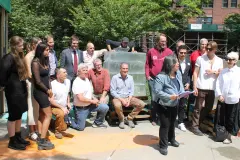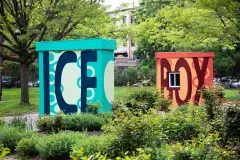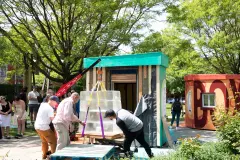Sto Corp. Co-Sponsored First-Ever US Collegiate Design-Build Passive House Ice Box Challenge with Pratt Institute
June 01, 2023Pratt Institute and Passive House for Everyone (PHFE) unveiled the results of the first-ever U.S. Collegiate Designed and Built rendition of the International Passive House Ice Box Challenge on May 8th, 2023 on Pratt’s Main Campus in Brooklyn, NY.
After sitting for one week, the 1,144-pound block of ice in the Passive House structure still weighed 900 pounds! An identical block of ice placed in the second structure, built according to the New York standard building codes was still very much intact, at 737 pounds. The remaining ice in the Passive House structure was 20% greater than the NY building code structure. As Pratt Institute visiting professor and founder of the climate education non-profit Passive House for Everyone, In Cho, mentioned in her remarks at the event, the hope was that the two structures would perform on par [roughly equal]. The NY code has improved since the last time the Ice Box Challenge was conducted in Time Square in 2018, but to see the results at the event emphasizes the benefits of Passive House principles.
About the Challenge
Sto Corp. teamed up with Pratt Institute and Passive House for Everyone (PHFE) as an advocate sponsor for the first-ever US Collegiate Designed and Built rendition of the International Passive House Ice Box Challenge. Created to demonstrate the essential role Passive House standards can play in mitigating the global climate crisis, the Ice Box Challenge has been an effective illustration around the world. Passive House design and construction has five principles that are fundamental to the energy efficiency of buildings, drastically reducing a building’s energy use while enhancing health and comfort.
The Pratt Institute’s Brooklyn Ice Box Challenge demonstrated these principles effectively and publicly as the architecture students designed and constructed two ice box structures, one according to local standard building codes and the other guided by high-performance Passive House building standards. Each structure housed an equal amount of ice at the beginning of the experiment, and at the end of the week the amount of ice left in each box was measured, with the level of ice remaining used to demonstrate how well each structure passively kept out the heat.

Professor Cho included the challenge as a key part of her curriculum. The students at Pratt were the first to feature a modular construction technique, which allows the two structures to be deconstructed and reassembled for future Ice Box Challenges.
Sto Corp. USA was more than just an advocate sponsor of the Ice Box Challenge. Dan Canova, Construction Design Manager at Sto Corp.USA, had provided hands-on training on Sto’s energy efficient system solutions in the US.
“This project was about educating our up-and-coming generation, so it was a real treat to get to work directly with the students,” Canova notes. His instruction was essential to this challenge as Sto Gold Coat®, an air and water-resistive barrier will be applied to the Passive House structure. Additionally, Sto is a contributor to the Passive House movement with a wide range of systems designed to minimize energy consumption. “Energy efficiency is a major focus of what we do at Sto. So, we were excited to be a part of Pratt Institute’s Ice Box Challenge and to support these rising students,” said Jose Berlingeri, President and Chief Executive Officer of Sto Americas, “Together with the next generation, we can start a new era of Building with conscience for new and retrofit construction.”
According to Cho, current building practices are a leading cause of climate change. “Buildings contribute up to 40% of carbon emissions that are conducive to climate change, and in dense cities like New York, that number is almost up to 70%.” Cho says Passive House principles can go a long way toward addressing these issues by lowering “heating and cooling energy demands by up to 90%.” While climate action is the primary thrust of Passive House principles, its appeal is multi-faceted. Cho added, “It’s great for energy efficiency, but it also creates incredible comfort and health,” referring to the cleaner, filtered air and more consistent temperatures inside Passive House buildings.
For additional information, please visit this website: https://iceboxchallenge.org/ or contact Sto Corp USA.


